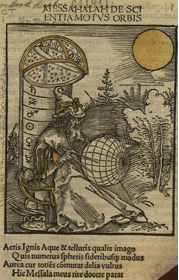!! exceptionnally : 16:00 – 18:30 !!
Univ. Paris Diderot, building Condorcet,
4 rue Elsa Morante, 75013 Paris,
Room Mondrian (646A)
 Nuremberg, 1504 (Johann Weissenburger).
Nuremberg, 1504 (Johann Weissenburger).
Wood engraving attr. to Albrecht Dürer.
Charles Burnett (Warburg Institute, Londres) and Barbara Obrist (CNRS, Univ. Paris Diderot) :
Introduction : the Latin Versions of the Liber de orbe
Taro Mimura (Univ. of Manchester) :
The Arabic Original of (ps.) Māshā’allāh, Liber de orbe : Date, Authorship, and Content
Shlomo Sela (Univ. of Bar-Ilan) :
The Reception of Māshā’allāh’s Cosmology in Twelfth-Century Jewish Thought
 Book of the Sphere. Pennsylvanie, Univ. of Pennsylvania
Book of the Sphere. Pennsylvanie, Univ. of Pennsylvania Rare Book and Manuscript Library, LJS, MS 439 (s. XIV).
This document, the importance of which has been recognized only very recently, raises such fundamental questions as those of its ultimate origin and of its elaborations - especially with regard to physics and geography -, of its Latin translations, as well as of its impact. Both the Arabic and the Latin versions are awaiting critical editions.
Bibliography :
![]() texts :
texts :
- Arabic versions :
- 1) Berlin, Staatsbibl. zu Berlin, Preussischer Kulturbesitz, MS. Or. Oct. 273 ;
- 2) Pennsylvanie, Univ. de Pennsylvanie, Rare Book and Manuscript Library, LJS, MS 439.
- Expanded Latin Version :
- 1) Florence, Bibl. Naz., MS Conv. Soppr. J. I. 132 ;
- 2) New York, Columbia Univ. Library, MS Plimpton 16 ;
- 3) Paris, BNF, MS lat. 15015.
- Short Latin Version : éds. Nuremberg, 1504 ; 1549.
![]() studies :
studies :
- B. Obrist, « William of Conches, Māshā’allāh, and Twelfth-Century Cosmology », Archives d’histoire littéraire et doctrinale du Moyen Age, 76 (2009), 29-87 ; EAD, « Twelfth-Century Cosmography, the De scecretis philosophie, and Māshā’allāh (attr. to), Liber de orbe », Traditio, 67 (2012), 235-76.
- D. Pingree, « Māshā’allāh : Some Sassanian and Syriac Sources », in Essays on Islamic Philosophy and Science, G. F. Hourani éd., New York, 1975, 5-14 ; ID., « The Indian and Pseudo-Indian Passages in Greek and Latin Astronomical and Astrological Texts », Viator, 7 (1976), 141-95.
- S. Sela, « Maimonides and Māshā’allāh on the Ninth Orb of the Signs and Astrology », Aleph, 12 (2012), 101-34.



